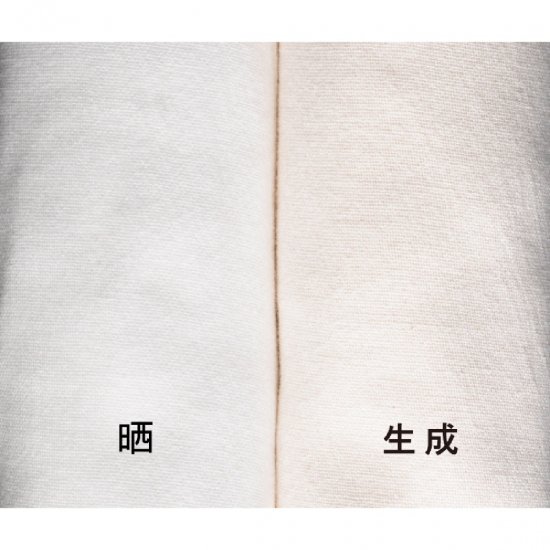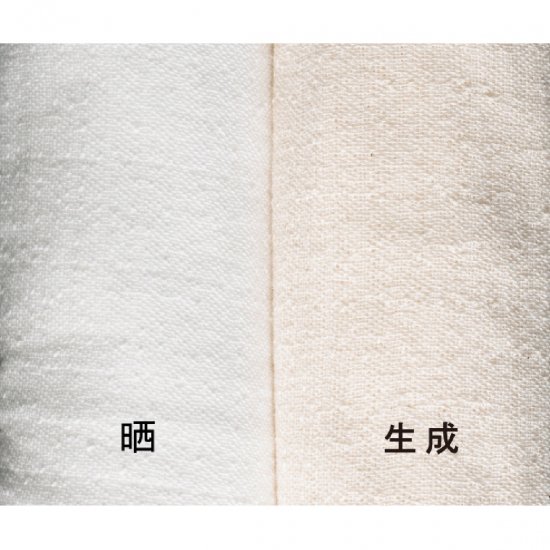
“泉州綿紗”について
日本に初めてタオルが輸入されたのは、明治5年と伝えられています。
明治20年、佐野村(現泉佐野市)の里井園治朗氏によって手動式のタオル織機が開発されました。
泉州綿紗は、泉州タオルに代々伝わる変則的な特殊ガーゼ織りにより、優しい手触りを残しながらも、今までのタオルにない薄さと軽さを同時に実現させたものです。
なかでも「二重半」は、この工場でしかつくられていない完全オリジナル。
20番手の糸を使い、3重ガーゼの真ん中の生地目を半分の荒さにして繊細に織り上げられています。
通常、綿には油分やロウなどの不純物が入っていて、その状態では水を吸いません。
そこで、それらを取り除くために「晒」という作業をします。
泉州の産地では、先に晒した糸を織り上げるのではなく、生地に仕上げてから晒しています。
織り上がった後にさらしにかけることで吸水性が上がり、肌触りの良さが際立つのです。
About'Sensyu-mensya'
It is said that the towel was first imported into Japan in year 5 of the Meiji Period (1872). From there, in Meiji 20 (1887), Enjiro Satoi developed the manual towel loom within the village of Sano-mura (now known as Sano-shi) in Japan’s Tochigi Prefecture.
Senshu-mensha, due to the exceptional gauze weaving technique passed on through generations of Senshu towel manufacturing, is known for realizing not only a gentle texture, but also for a remarkable lightness and thinness that has yet to be seen in any other towels variants to date.
Among Senshu-mensha variants is‘Niju-han,’ a style completely unique to our factory. Using 20-count yarn, Niju-han is woven carefully while keeping the fabric texture in the middle of the three-layer gauze at half roughness.
Normally, cotton cannot absorb water in its natural state, as it is home to oils, wax, and other impurities.
For that reason, one must perform‘sarashi,’ which is the process of removing such impurities by bleaching the fabric through leaving it out in the sun.
Within the production region of Senshu, they engage in the process of ‘sarashi’ after weaving and finishing the fabric itself, as opposed to proceeding with weaving after bleaching the yarn first.
By bleaching the fabric after it has been woven together, the material’s capacity to absorb moisture increases, while at the same time providing for an outstanding texture that is pleasant to the touch.
つくっているところ
神藤タオル株式会社
明治40年創業。泉佐野の地でタオルの製造が始まった当初からある老舗でありながら、まだ30代である若い社長のもと、企画から製品づくりまで社内一体となって取り組んでいます。
Where It’s Made
SHINTO TOWEL
First established in Meiji period year 40 (1907). Although SHINTO TOWEL is old and established firm existing since the towel manufacturing trade first began in the Izumisano area, SHINTO TOWEL is currently under the guidance of a president who is still in his 30’s. Under the freshness of his youth and his direction, the towel production process—starting from planning and going into production—is handled entirely in-house.
おすすめのつかいかた
生地幅が90cmあるので、タオルケットや夏場のブランケットとしてもお使い頂けます。
ガーゼは春夏のイメージがありますが、「二重半」は秋冬用の洋服地としておすすめします。
しっかりとした厚みがあり、生地の間に空気の層が出来る為温かく、肌触りもひんやりしません。
Recommended Usage
The fabric possesses a width of about 90 centimeters—meaning one can use Senshumensha as a towel-blanket, or as a blanket for use in summer.
Gauze fabrics are often associated with spring and summer clothes, but we recommend using ‘Niju-han’ as a fabric for fall and winter western-style clothes.
The fabric possesses a sturdy thickness while also allowing for pockets of air to develop between the layers of fabric—leading to a warmth and sensation that is not overly cool to the touch.


